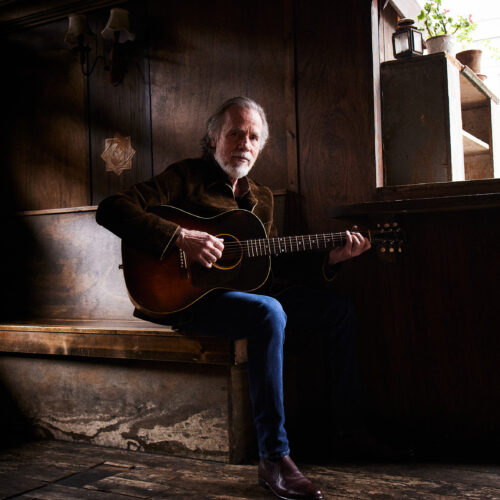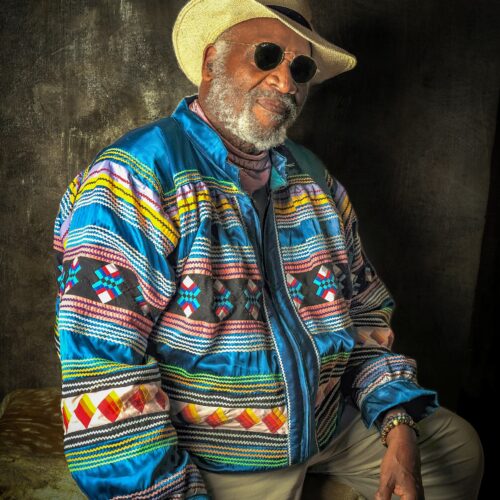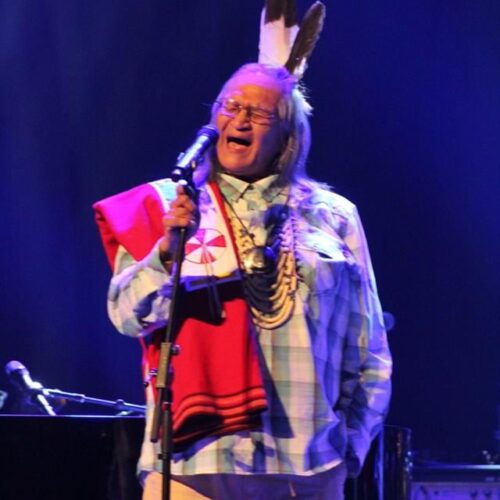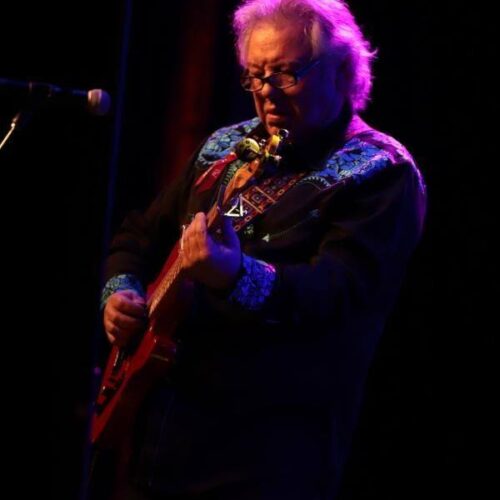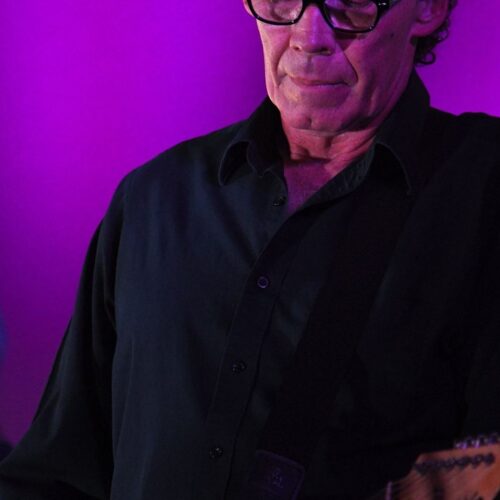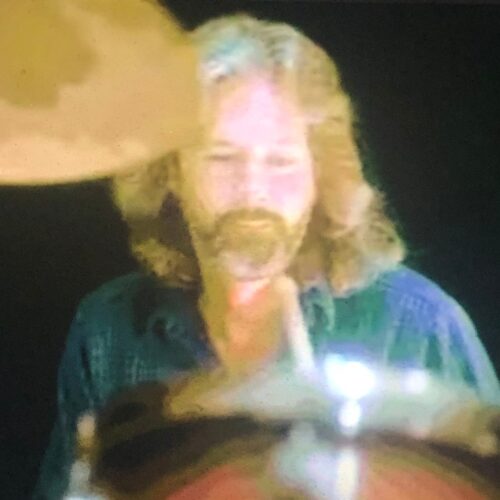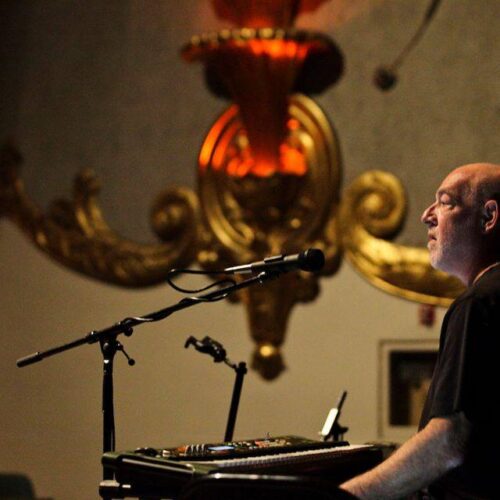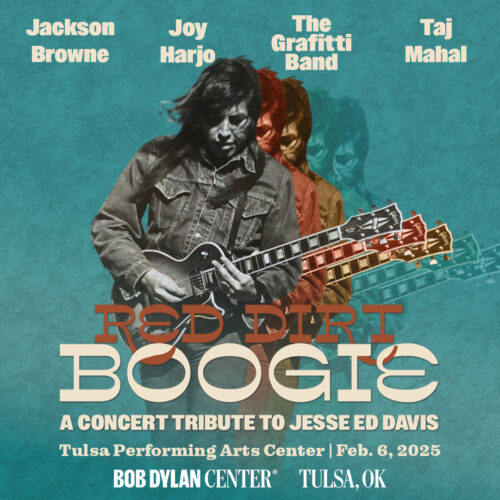All-star lineup celebrates the life and legacy of the legendary rock ‘n’ roll musician and member of the Native American Music Hall of Fame as tie-in to Bob Dylan Center exhibition “Jesse Ed Davis: Natural Anthem”
TULSA, Okla. (Dec. 3, 2024) —The Bob Dylan Center presents “Red Dirt Boogie: A Concert Tribute to Jesse Ed Davis,” featuring an exciting roster of former Davis collaborators including (in alphabetical order): Rock and Roll Hall of Fame member and iconic singer-songwriter Jackson Browne, whose classic 1972 top-ten single “Doctor My Eyes” features Davis on lead guitar; three-term U.S. Poet Laureate and Bob Dylan Center Artist-in-Residence Joy Harjo, who recorded with Davis in the early 1980s; members of The Grafitti Band (Ricky Eckstein, Gary Ray, Quiltman Sahme, Mark Shark, Billy Watts), who backed Davis and Native artist John Trudell on their acclaimed release “aka Grafitti Man” (named by Bob Dylan as one of his favorite albums); and Blues Hall of Fame member and four-time Grammy Award winner Taj Mahal, with whom Davis recorded and toured for many years. The performers will be joined by two additional musicians who played with Davis at different points throughout his career—Gary Gilmore and Bob Glaub—along with Garrett Ray (son of The Grafitti Band’s Gary Ray).
This one-night-only celebration of Davis’s expansive musicality and enduring impact will take place on Thursday, Feb. 6 at Tulsa Performing Arts Center. The concert is the major public program associated with the Dylan Center’s “Jesse Ed Davis: Natural Anthem” exhibition, on view through April 27, 2025 and co-curated by featured artist Harjo and Davis scholar Douglas Miller, whose biography “Washita Love Child: The Rise of Indigenous Rock Star Jesse Ed Davis” was published by Liveright on Nov. 12. Miller also serves as co-producer of a forthcoming archival album set of unissued Davis music titled “Tomorrow May Not Be Your Day.”
Reuniting for this special event following a long hiatus, members of The Grafitti Band will serve as the evening’s house band, backing sets by Browne, Harjo and Mahal as they perform songs originally written or recorded by Davis, or featuring him on guitar.
Drummers and singers from the Kiowa Nation will set a respectful and powerful doorway for the show by performing a traditional honor song as a gesture to Davis’s cultural heritage.
In addition, Tulsa-based filmmaker, creator of the acclaimed FX series “Reservation Dogs” and recently named MacArthur Fellow Sterlin Harjo will present a brief reading on what Davis’s music and legacy mean to him as a fellow Native American artist.
Tickets go on sale to Bob Dylan Center members on Wednesday, Dec. 4 at 10 a.m. CT, to Jackson Browne Fan Club members on Thursday, Dec. 5 and to the general public on Friday, Dec. 6 at 10 a.m. CT. Ticket prices range from $30 to $150, with a variety of ticket packages and benefits available at various price levels. Visit bobdylancenter.com for detailed information and links to ticket purchase.
“Jesse played with tremendous grace, power and fluidity, and he elevated everyone who had the good fortune to make music with him,” says Jackson Browne.
“I knew Jesse as a fellow musician and always appreciated his artistry, his innovation and vision in a time of cultural shift for Native people and this country,” says Harjo, the three-time U.S. Poet Laureate who serves as the Bob Dylan Center’s inaugural Artist-in-Residence.
“Be my expressed pleasure to be in attendance!!” says Taj Mahal. “And to pay a long overdue tribute to my Brother Jesse ‘Ed’ Davis.”
Speaking collectively, the reunited members of The Grafitti Band comment, “We are honored to come together again and shine a light on one of the most gifted, soulful and undeniably talented artists of the twentieth century, brother Jesse Ed Davis. Jackson Browne and Taj Mahal fully supported and shared in The Grafitti Band journey and we are grateful for their enduring love as we celebrate the incredible artistry Jesse Ed Davis gifted the world.”
“We intend for this evening to do full justice to Jesse’s remarkable artistry and lasting impact,” says Steven Jenkins, director of the Bob Dylan Center. “While Jesse left us far too early nearly 40 years ago, his music and spirit live on, and I can’t wait to hear what Jackson, Joy, Taj and The Grafitti Band have in store for both longtime fans and newcomers to Jesse’s body of work.”
“Red Dirt Boogie: A Concert Tribute to Jesse Ed Davis” is generously supported by presenting sponsor Joe Donnelly as well as by the Hardesty Family Foundation.
# # #
For more information about the event, to become a member and to keep up to date on ticket releases visit bobdylancenter.com and subscribe to the newsletter.
About “Jesse Ed Davis: Natural Anthem”
A career-spanning exhibition celebrating the life and legacy of Jesse Ed Davis, legendary rock ‘n’ roll musician and member of the Native American Music Hall of Fame, opened to the public at the Bob Dylan Center on Friday, Nov. 15, 2024 and runs through April 27, 2025.
Like Dylan, Davis was a fearless and uncompromising artist, steadfastly dedicated to his craft and thriving as a collaborator with fellow musicians such as Jackson Browne, Taj Mahal, John Lennon, Leon Russell, Eric Clapton, Johnny Cash, Neil Diamond, Leonard Cohen, Rod Stewart and Dylan himself. Unlike Dylan, however, Davis’s significance as a musician, songwriter and, notably, Native American artist has been unjustly neglected since his passing in 1988, an oversight the exhibit aims to correct.
Exhibit co-curators Joy Harjo and Doug Miller delve into Davis’s origin story and family background and chart his ascendance as a songwriter and go-to guitarist for a who’s-who of 1970s musical icons. The exhibit also considers his embodiment of the Kiowa Nation’s “warrior” archetype and celebrates his enduring legacy as an influential guitarist and cultural figure.
As curators, Harjo and Miller have assembled a trove of previously unheard recordings and unseen images; Davis’s instruments and personal mementos; striking photographs of Davis and fellow musicians such as Dylan, George Harrison and Rod Stewart; and items on loan from Davis’s relatives exclusively for the exhibit.
“Jesse Ed Davis: Natural Anthem” is generously supported by presenting sponsor Joe Donnelly.
About Jesse Ed Davis
Jesse Ed Davis (September 21, 1944–June 22, 1988) was a Native American singer-songwriter, guitarist, producer and in-demand session musician who played on dozens of classic recordings throughout the late 1960s and ‘70s. His list of collaborators includes Bob Dylan (on the Leon Russell–produced “Watching the River Flow” and “When I Paint My Masterpiece”), Joy Harjo, Taj Mahal, John Lennon and George Harrison (with whom he performed at the Concert for Bangladesh). In 1985, Davis formed the Grafitti Band, which coupled his music with the poetry of Native American activist John Trudell. Their album “aka Grafitti Man” was one of Dylan’s personal favorites. Davis has been referred to as “the guitar hero’s guitar hero,” and self-effacingly claimed of his own virtuosity, “I just play the notes that sound good.”
Born in Norman, Okla., and raised in Oklahoma City, Jesse’s first major gig saw him backing Conway Twitty while attending the University of Oklahoma. Davis’s background as an enrolled citizen of the Kiowa Nation, as well as a proud Comanche, Cheyenne, Muscogee and Seminole provided strength in his music and career. Struggling with addiction in his later years, Davis served as a drug and alcohol counselor at the American Indian Free Clinic in Long Beach, Calif., but died from a lethal drug injection in 1988. Davis was posthumously inducted into the Oklahoma Jazz Hall of Fame in 2002 and the Native American Music Hall of Fame in 2018.
Like Dylan, Davis was a fearless and uncompromising artist, steadfastly dedicated to his craft and thriving as a collaborator with fellow musicians such as Jackson Browne, Taj Mahal, John
Lennon, Leon Russell, Eric Clapton, Johnny Cash, Neil Diamond, Leonard Cohen, Rod Stewart and Dylan himself. Unlike Dylan, however, Davis’ significance as a musician, songwriter and, notably, Native American artist has been unjustly neglected since his passing in 1988, an oversight the exhibit and accompanying “Red Dirt Boogie” concert aim to correct.
About Jackson Browne
Over the course of more than 50 years, Jackson Browne has written and performed some of the most literate and moving songs in popular music. With classic albums including “Late for the Sky,” “The Pretender,” “Running on Empty” and “For Everyman,” Browne has defined a genre of songwriting that is charged with honesty, emotion and personal politics.
A member of the Rock and Roll Hall of Fame and the Songwriters Hall of Fame, Browne emerged from the Laurel Canyon music scene in the early 1970s and became a regular performer at The Troubadour in Los Angeles. He recorded his now-iconic self-titled debut for David Geffen’s Asylum Records in 1972. Forming a tight-knit musical partnership with David Lindley the following year, they would go on to create some of the most beloved releases of the decade, including the Jon Landau–produced 1976 fan-favorite “The Pretender” and its seven-time Platinum-selling follow-up “Running on Empty.”
In all, Browne has released 15 studio albums and four collections of live performances, and has sold more than 22 million albums worldwide. His highest-charting single, 1982’s “Somebody’s Baby,” was closely followed by the full-length “Lives in The Balance,” named one of the “Greatest Albums of the 1980s” by Rolling Stone. Subsequent releases examine topics and weave together social and political struggle (“World in Motion”), matters of the heart (“I’m Alive”), personal growth and the interconnectedness of the world around us (“Looking East”). He has been nominated for seven Grammys, including for “Solo Acoustic, Vol 1” (2005), “Love Is Strange: En Vivo Con Tino” (2010) and his latest album “Downhill from Everywhere” (2021). As a producer for other artists, his work includes David Lindley’s debut “El Rayo-X” as well as Warren Zevon’s self-titled release and “Excitable Boy.”
Browne’s advocacy for social and environmental justice has been braided together with his music throughout his career. He has been the recipient of Duke University’s LEAF Award for a
Lifetime of Environmental Achievement in Fine Arts, the NARM Harry Chapin Humanitarian Award and The John Steinbeck Award, given to artists whose works exemplify the environmental and social values that were essential to the great California-born author. He has also been honored with the Gandhi Peace Award, the Grammy Museum Jane Ortner Education Award, the We Are Family Humanitarian Award and the American Music Honors from The Bruce Springsteen Archives and Center for American Music.
About Joy Harjo
Bob Dylan Center Artist in Residence Joy Harjo is only the second poet to be appointed a third term as U.S. Poet Laureate. Born in Tulsa, Okla., Harjo is a member of Muskogee Nation and active in Native empowerment movements.
Harjo is the author of a dozen volumes of poetry as well as memoirs, plays, children’s books and other works. As a singer, songwriter and saxophonist, Harjo has released many recordings and performed internationally. Harjo’s awards include the 2024 Frost Medal from the Poetry Society of America, Yale’s 2023 Bollingen Prize for American Poetry, a Lifetime Achievement Award from Americans for the Arts, a Ruth Lily Prize for Lifetime Achievement from the Poetry Foundation, the Academy of American Poets Wallace Stevens Award, a PEN USA Literary Award, the Poets & Writers Jackson Poetry Prize, two NEA fellowships, a Guggenheim Fellowship and a National Book Critics Circle Ivan Sandrof Lifetime Achievement Award, among others.
Harjo is a chancellor of the Academy of American Poets and served as a founding board member and Chair of the Native Arts and Cultures Foundation. She is a member of the American Academy of Arts and Letters, the American Philosophical Society, the National Native American Hall of Fame and the National Woman’s Hall of Fame.
About Taj Mahal
In a career spanning seven decades and almost 50 albums, Taj Mahal has not only helped popularize and reshape the scope of the blues but also personified the concept of World Music years before the phrase even existed. From a base of traditional country blues, Taj has explored and incorporated reggae, Latin, R&B, Cajun, Caribbean, gospel, West African, jazz, calypso, Hawaiian slack-key and countless other musical styles into his astonishing body of work.
Along the way, he has become proficient on about 20 different instruments and collaborated with a vast range of musicians including The Rolling Stones, Eric Clapton, Etta James, Angelique Kidjo and Ziggy Marley, and masters from India and Mali. For his work, Taj has won four Grammy Awards (out of fifteen nominations), been inducted into the Blues Hall of Fame and was a recipient of the Americana Music Association’s Lifetime Achievement Award.
Born to a musical family in the vibrant immigrant community of Springfield, Massachusetts, Taj developed an early interest in African music and the blues. He studied ethnomusicology at the University of Massachusetts (while majoring in agriculture) before heading to Los Angeles to pursue music. With his group, the Rising Sons—one of the first interracial bands on the scene—he opened for Otis Redding and The Temptations and mingled with giants like Howlin’ Wolf and Muddy Waters. He and bandmate Ry Cooder collaborated with The Rolling Stones, leading to Taj’s unforgettable appearance (with Jesse Ed Davis) in the 1968 film “The Rolling Stones Rock and Roll Circus.”
He began his solo career with such pioneering projects as “The Natch’l Blues” and the expansive double album “Giant Step/De Old Folks at Home,” demonstrating his ambitious sense of possibility for American roots music. In the 1970s, his records became even more adventurous, incorporating more global influences. His impact even reached Hollywood, as he acted in and wrote the Grammy-nominated music for the acclaimed 1972 film “Sounder,” the first of several scores and soundtracks he would contribute to stage and screen.
After moving to Hawaii in 1981, he formed the Hula Blues Band, adding the music and culture of his new home to his sound and releasing a series of beloved children’s albums. In the ‘90s, Taj continued to expand his multicultural horizons with such landmark albums as “Mumtaz Mahal,” a 1995 collaboration with Indian classical musicians, and 1999’s “Kulanjan,” a project with Malian kora master Toumani Diabate that Taj felt represented his musical spirit truly “arriving full circle.” He won back-to-back Grammys for Best Contemporary Blues Album with “Señor Blues” and “Shoutin’ in Key.”
The 21st century has seen Taj Mahal working with many of the remarkable musicians who were directly influenced by his work and his example, including Keb’ Mo, Los Lobos and Ben Harper. He remains not only active and vital but continues to push artistic boundaries; his reunion with
Ry Cooder on 2022’s “Get On Board” won his latest Grammy, for Best Traditional Blues Album, and his most recent releases, “Savoy” (a collection of classic jazz songs) and “Taj Mahal Sextet – Swingin’ Live at the Church Studio in Tulsa” (also Grammy-nominated), are the first two of an astonishing six albums scheduled for release over the next two years. Yet this towering figure believes that his lifelong project of looking forward and back, connecting the blues to its roots and its offshoots around the world, is still misunderstood.
“They don’t get it, they really have no idea what I do,” he recently said. “They’ll say, ‘He’s into this exotic jazz.’ It has nothing to do with any of that. It has to do with the amazing contributions African-based people have made to music.”
About The Grafitti Band
The inception of The Grafitti Band began in 1983 when Jesse Ed Davis heard Native American artist John Trudell reciting his poetry to a captivated audience in Los Angeles. Inspired by Trudell’s words and message, Davis introduced himself to the poet, saying, “I can make music for your words.” From that moment, Davis and Trudell along with Quiltman (from Warm Springs), a singer who Trudell worked with on his first recording, “Tribal Voice,” and a group of local musicians—Ricky Eckstein, Gary Ray, Mark Shark, Bobby Tsukamoto and Billy Watts— made some of the most unique, moving and compelling music of the era from Eckstein’s garage studio in Culver City, known as R&L Productions. The Grafitti Band deliberately stuck with their misspelled name following an inadvertently printed typo.
The musical collective released the acclaimed albums “Heart Jump Bouquet” and “aka Grafitti Man,” blending Trudell’s poetry with Davis’s rich musical tapestries and the band’s soulful playing. Bob Dylan named “aka Grafitti Man” the best album of 1986.
About the Bob Dylan Center
The Bob Dylan Center inspires and celebrates fearless creativity by exploring the music and artistry of the Nobel Prize–winning singer-songwriter as a catalyst for personal expression and cultural change.
As the primary public venue for the Bob Dylan Archive® collection, the center curates and exhibits a priceless collection of more than 100,000 items spanning Dylan’s career, including handwritten manuscripts, notebooks and correspondence; films, videos, photographs and artwork; memorabilia and ephemera; personal documents and effects; unreleased studio and concert recordings; musical instruments and many other elements. The center presents a full roster of public programs including concerts, film screenings and author talks. Since opening in May 2022, the Bob Dylan Center has welcomed visitors from all 50 states and nearly 40 countries. The center has garnered numerous design awards and accolades from publications including the New York Times, Vanity Fair, Variety, Uncut and Mojo.


